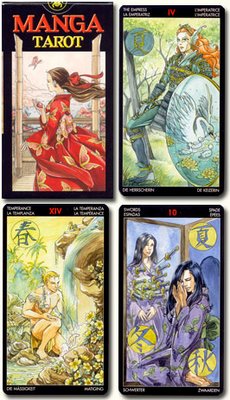REVIEW OF THE MANGA TAROT (Llewellyn/Lo Scarabeo)

For a while now I've been wanting to get some Tarot decks that reach beyond my comfort zone, i.e. my personal tastes in art and/or cultures. One of those areas is Manga art. I have had some exposure to Manga (and Anime) as my roommate is a huge fan, her walls (and one of our shared hallways) are hung with posters she's collected. I've also watched a couple of anime movies with her and begun to appreciate what it offers visually, and I've enjoyed two of her Manga books -- both with Tarot images in the stories. So when I became aware of Llewellyn/Lo Scarabeo's Manga Tarot I looked forward to getting it, and I have not been disappointed.
This is a colorful and lively deck, with a variety of images from the tender and the mystical, to the tough and aggressive. Although it has some innovations, such as The Moon on which a woman apparently dances with a polar bear, it has mostly fairly recognizable traditional Tarot images.
One interesting diversion from the usual is in the sex of various figures, most being reversed, i.e., male when they are usually female and vice versa. E.g., the Three of Cups is three male figures in female Japanese garb holding open fans; and The Magician is the Sorceress. There is also some changing of the numbers usually assigned to cards. III is assigned to the usually IV Emperor, and IV is assigned to the usually III Empress, more sex reversal. The little white book ("LWB") mentions these sex reversals but without much clear explanation. However, these reversals seem consistent with what I've seen of Manga and Anime, in which men can often be "pretty" and women be exceptionally "aggressive."
I find the deck's innovations and reversals refreshing. They shake up my tendency to go on "auto-pilot" when viewing the cards. But more importantly they stir up new understandings of the cards, new nuances. At the very least they add some extra zest to a friendly familiar stew.
Figuring out which of the "glyphs" -- a Japanese ideogram in a circle on each card that represents one the four seasons -- is which season and therefore has which attributes as indicated in the LWB was a problem. Each card has one season glyph, while the Aces each have all four, and the tens each have only three -- the missing one said to be important by the LWB. So it does seem good -- if not crucial -- to know which glyph represents which season when using this deck. Of course, this use of a season glyph immediately called to mind the season word traditionally used in haiku. And, to my lights, serves the same purpose as a haiku season word -- providing a sense of setting/continuity. I finally did an internet search for Japanese ideograms and luckily found them on first hit. I list them below for anyone wanting to know what they are as I did.




The LWB also offers some unusual and intriguing phrases for each of the cards. Such as for The Empress: "A shameless glance indicates an unblemished conscience." Hm. Or for the King of Swords: "Only by comparing different opinions can the limits of your thinking be found."
I had my roommate look through this deck in order to get her sense of how well it honors Manga. She was very impressed as a whole, saying it nicely evokes the Manga art form. Based on my own admittedly limited exposure, I agree with her assessment. However, I hasten to add, that this deck stands alone simply as a Tarot.
I leave it to anyone new to Tarot whether or not they want to start with a somewhat non-traditional deck. Except to add that when it comes to the variety of decks out there these days, one is always "translating" anyway across the various differences in imagery and meaning. For all this deck's quirks in sex assignment and numbering, and the difficulty in determining which of the season glyphs is which, I think it makes a wonderful addition to any Tarot collection, and could work beautifully as one's only deck. I will certainly turn to this Manga Tarot again and again, especially when I need to shake up my preconceptions, and invite in the new and unusual.
Resource: Manga Tarots. Though called Manga these are, at least to my limited understanding, more in the tradition of Anime. But they are fun to view as they show some of the various styles in which Tarot is being developed.
Please see the top of the sidebar for my background with the Tarot and a recommendation to beginners.
‘til next time, keep enjoying the beauty and variety of The Tarot,
Roswila
[aka: Patricia Kelly]
****If you wish to copy or use any of my writing, please email me for permission (under “View my complete profile”)**** SEE ALSO: Roswila’s Dream & Poetry Realm for some articles about Tarot.****
Labels: Manga Tarot



0 Comments:
Post a Comment
<< Home